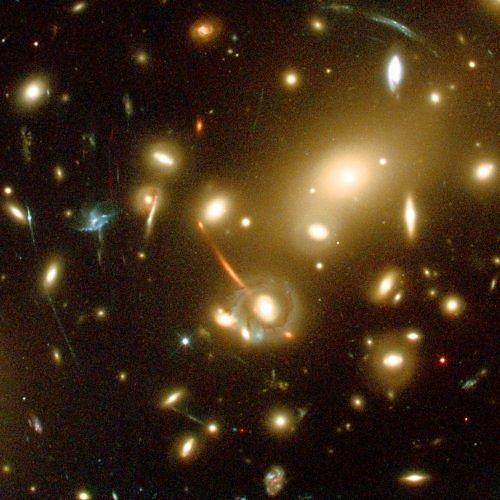He calls it “the haze,” and if that sounds vague, it’s on purpose. Douglas Finkbeiner, an astronomer at Princeton University, isn’t sure what causes the excess of microwave radiation he discovered coming from the Milky Way’s center. But he has an exciting proposal: It may be an indirect observation of dark matter.
“The WMAP team cares about the cosmological signal and has carefully removed the foreground signals so they don’t interfere with it,” says Finkbeiner, “but these foreground signals are interesting in their own right.”
According to WMAP scientists, non-cosmological microwaves could come from ionized hydrogen in our own Milky Way Galaxy, interstellar dust, and from the fast electrons found in supernova remnants. But Finkbeiner set out to quantify these local sources to see if, together, they match the non-CMB component of WMAP’s observations.
They do, he found, with one interesting exception: An unexplainable haze surrounds the center of the Milky Way, extending out to about 20º on the sky. If you take account of its strength at different wavelengths, this radiation looks like what ionized hydrogen atoms emit — only there aren’t enough of those around. The radiation also looks like what would be emitted by fast electrons in a magnetic field — but they would have to be moving near the speed of light.
And that’s what gave Finkbeiner the idea that he might have discovered the signal of dark matter. He has put forward his theory in an as-yet-unpublished paper and at a conference on dark matter held in Edinburgh, Scotland, in September.
Astronomers agree there is vastly more matter in the universe than their telescopes can observe. They infer it from galaxies’ motions, from the behavior of light that is gravitationally lensed by galaxy clusters, and from models of the universe’s expansion. Candidates for dark matter include subatomic particles that different advanced physical theories predict. If they exist in sufficient number, and have sufficient mass, such particles could play the part. All of these dark-matter candidates have one thing in common: They don’t interact much with the kind of matter that makes stars and people. We would see them if they did. For this reason, such subatomic candidates are also called WIMPs, for Weakly Interacting Massive Particles.
But there’s a loophole. Some of these particles can interact with each other — even annihilate one another. When electrons meet their antiparticle, the positron, both particles vanish in a burst of gamma rays. Strangely, some of the dark-matter candidates effectively become their own antiparticle, in the same way that 0 is its own inverse number, and 1 its own reciprocal.
Take the neutralino, for example. It’s the lightest stable particle predicted by a theory called supersymmetry and is one of the more popular WIMPs for explaining dark matter. No one knows if neutralinos actually exist, but scientists can calculate how often they would interact among themselves and what the result of such interactions would be.
As it turns out, the annihilation of neutralinos briefly brings other particles into existence — including pions, electrons, and positrons — that can attain enormous speeds. When moving through a magnetic field, fast-moving charged particles emit synchrotron radiation of exactly the kind WMAP has detected, according to Finkbeiner’s calculations. He notes that the way the microwave excess increases toward the center of our galaxy nicely matches the expected distribution of dark matter.
These fast electrons and positrons also interact with starlight and with the cosmic background radiation itself. They kick photons up to much higher energies, so that we observe them as X and gamma rays. Astronomers have noted an excess of gamma rays toward the galactic center, something Finkbeiner’s idea may also explain.
Like a cosmic mirage, Finkbeiner’s haze may appear to show us something that’s not really there, but he points to observations that could be made to confirm or refute it. If gamma rays from the galactic center are, indeed, scattered starlight, then astronomers should be able to observe X rays from scattered CMB radiation, too. Gamma rays at the frequency corresponding to the annihilation of neutralinos should be detectable by the Gamma Ray Large Area Space Telescope, a satellite to be launched in 2006.
“If it turns out the haze results from dark-matter annihilation, that would be a major breakthrough in understanding what dark matter is,” he says.
And finally, it is possible that the neutralino will be observed in future particle colliders on Earth. So the race is on between particle physicists and astronomers to find — or dismiss — the neutralino as a component of dark matter.










